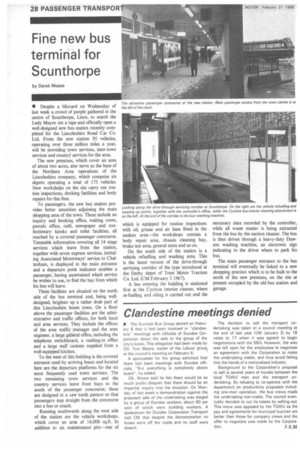Fine new bus terminal for Scunthorpe
Page 30

If you've noticed an error in this article please click here to report it so we can fix it.
by Derek Moses • Despite a blizzard on Wednesday of last week a crowd of people gathered in the centre of Scunthorpe, Lines, to watch the Lady Mayor cut a tape and officially open a well-designed new bus station recently completed for the Lincolnshire Road Car Co. Ltd. From the new station 95 vehicles, operating over three million miles a year, will be providing town services, inter-town services and countrY services for the area.
The new premises, which cover an area of about two acres, also serve as the base of the Northern Area operations of the Lincolnshire company, which comprise six depots operating a total of 175 vehicles. New workshops on the site carry out routine inspections, docking facilities and body repairs for this fleet.
To passengers, the new bus station provides better amenities adjoining the main shopping area of the town. These include an inquiry and booking office, waiting room, parcels office, cafe, newspaper and confectionary kiosks and toilet facilities, all reached by a covered passenger concourse. Timetable information covering all 54 stage services which leave from the station, together with seven express services, including Associated Motorways' service to Cheltenham, is displayed in the main entrance and a departure point indicator enables a passenger, having ascertained which service he wishes to use, to find the bay from which his bus will leave.
These facilities are situated on the north side of the bus terminal and, being welldesigned, brighten up a rather drab part of this Lincolnshire boom town. On a floor above the passenger facilities are the administrative and traffic offices, for both local and area services. They include the offices of the area traffic manager and the area engineer, a large general office, including the telephone switchboard, a cashing-in office and a large staff canteen supplied from a well-equipped kitchen.
To the west of this building is the covered entrance used by arriving buses and located here are the departure platforms for the six most frequently used town services. The two remaining town services and the country services leave from bays to the south of the passenger concourse; these are designed in a saw tooth pattern so that passengers step straight from the concourse into a bus or coach.
Running southwards along the west side of the station are the vehicle workshops, which cover an area of 14,000 sq.ft. In addition to six maintenance pits—one of which is equipped for routine inspections with oil, grease and air lines fitted in the sunken area—the workshops contain a body repair area, chassis cleaning bay, brake test area, general store and so on.
On the south side of the station is a vehicle refuelling and washing area. This is the latest version of the drive-through servicing corridor of the type introduced at the Derby depot of Trent Motor Traction Co. Ltd. (CM February 3 1967).
A bus entering the building is stationed first at the Cyclone interior cleaner, where re-fuelling and oiling is carried out and the necessary data recorded by the controller, while all waste matter is being extracted from the bus by the suction cleaner. The bus is then driven through a heavy-duty Dawson washing machine, an electronic sign indicating to the driver where to park his bus.
The main passenger entrance to the bus terminal will eventually be linked to a new shopping precinct which is to be built to the north of the new premises, on the site at present occupied by the old bus station and garage.












































































































